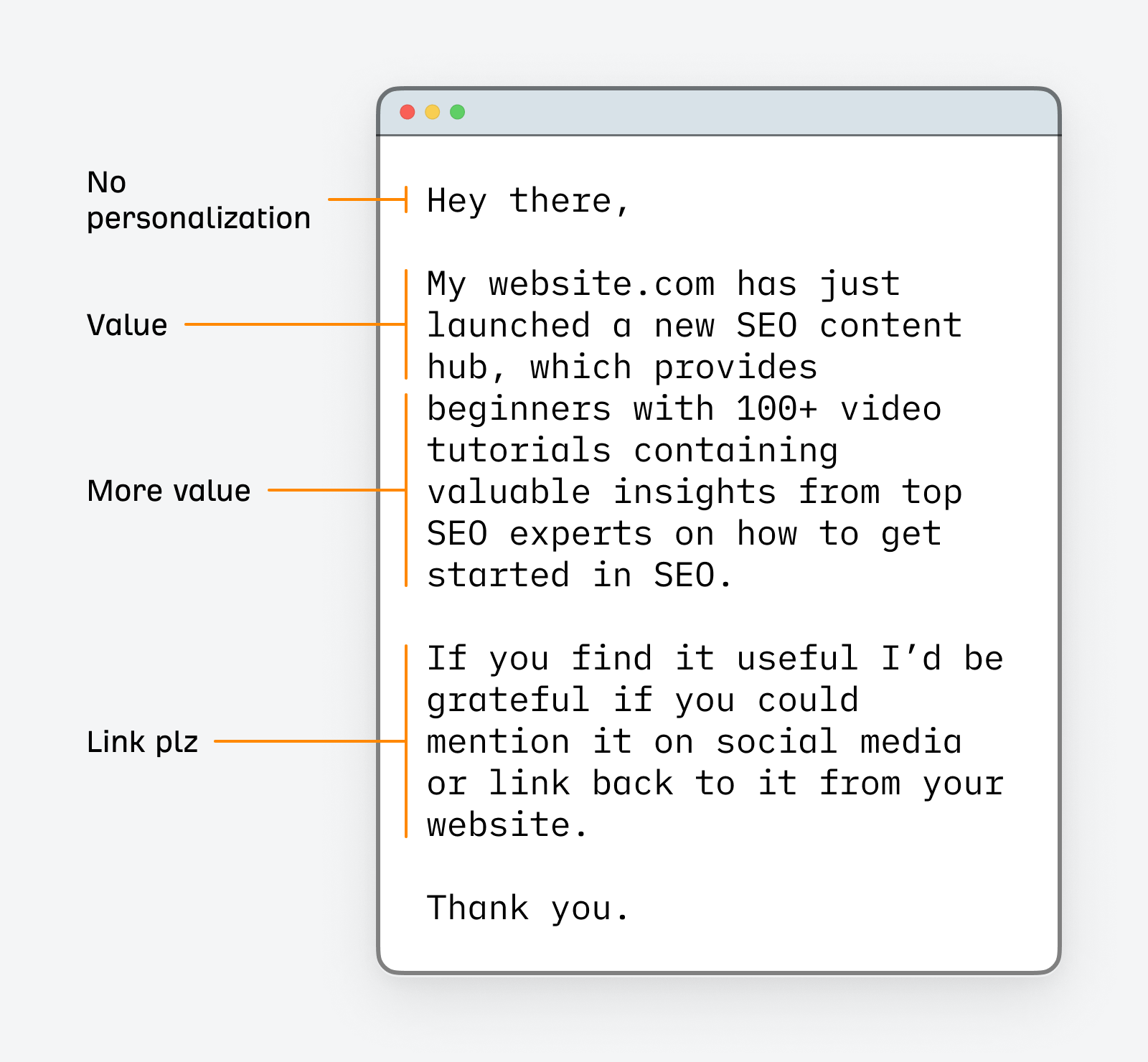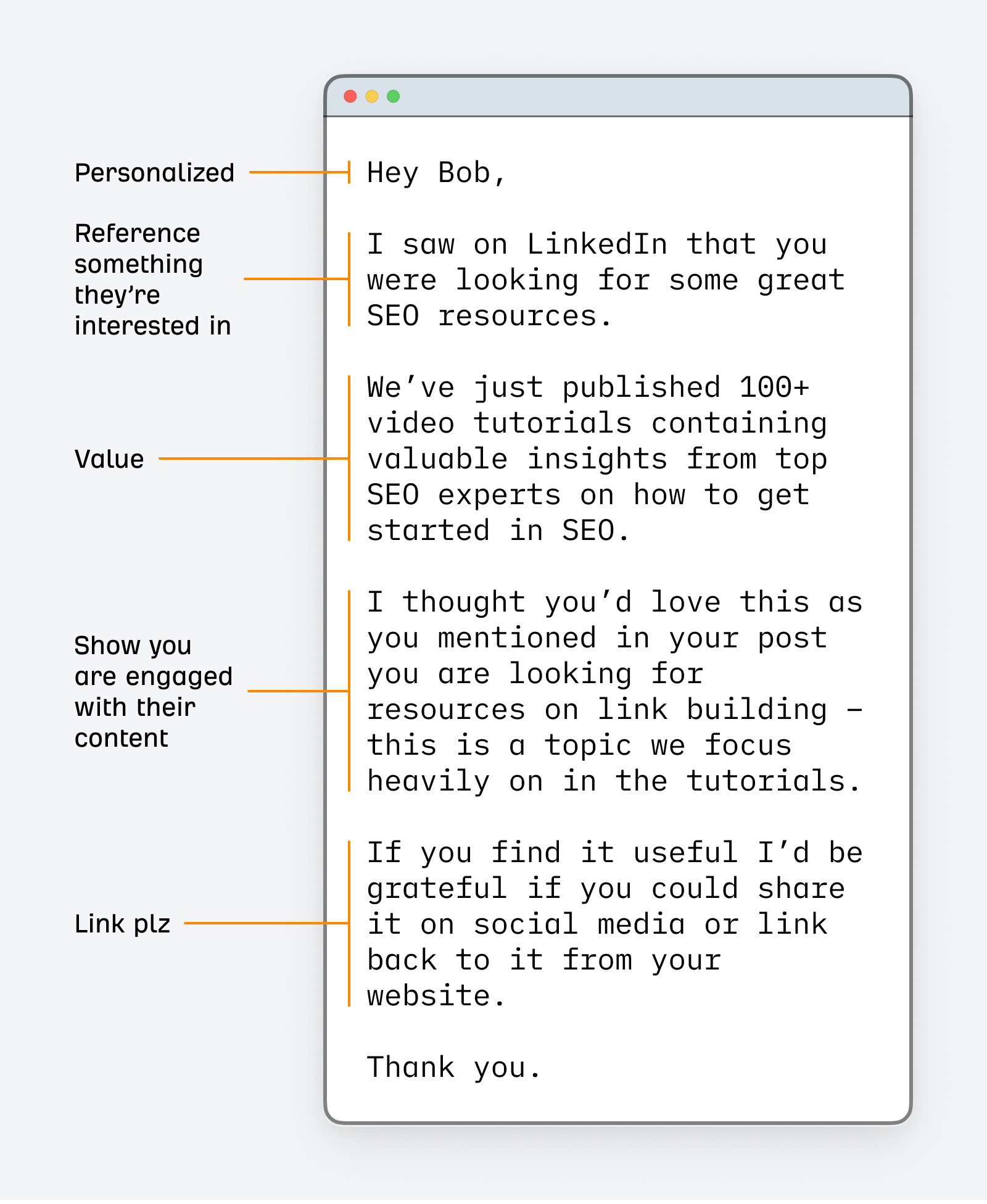SEO outreach is the practice of contacting website owners and asking them for links back to your website. But what’s the best approach to take?
Links are a major Google ranking factor. Even if they weren’t, a link from a popular website back to yours would send visitors to your site—and make your company and brand look good.
But high-quality backlinks don’t build themselves—you need to be proactive to get them. That’s where SEO outreach comes in.
Waking up and discovering you’ve landed a link from the New York Times or other high authority sites just isn’t going to happen unless you:
- Create something valuable
- Find a suitable audience to reach out to
- Tell publishers about it (using a compelling pitch)
Create something valuable
If you offer something of value to the prospect when you’re pitching to them, you may save your email from being instantly slam-dunked into the trash can.
It needs to be something their audience will love—you’ll then stand the highest chance of being credited with a backlink to your site.
Here are 9 ideas for creating something publishers want to publish on their website.
| What it is | Pitch |
| New industry research | Provide your prospect with updated research around a topic they’ve already written about already |
| New statistics | Provide new statistics that are relevant to your industry that prospects would be interested in |
| New survey results | Provide the results of a survey you have created on a topic they’re interested in or have written about already |
| Expert quotations | Be the source of expertise for a topic by providing quotes on a topic your prospect’s written about |
| Updated content | Provide your prospect with some updated content on a topic they may be interested in |
| New course | Share your course with a prospect whose audience would find it interesting |
| New guides or learning resources | Share your learning resources with a prospect whose audience would find it useful |
| New videos | Share a video that your prospect’s audience would find interesting |
| Something that’s entertaining | Share something entertaining that your prospect’s audience would find entertaining |
This is not a complete list, but with a bit of creativity, you could use this as a basis to identify something of value within your industry that you can use to pitch to publishers.
Find a suitable audience
Identifying a suitable audience for your topic is easy with the help of a tool like Ahrefs’ Content Explorer. Let’s say I wanted to pitch a new series of SEO statistics to someone who has written about the topic already.
To do this, start by entering the broad topic—I’ve entered “SEO statistics.”
Once you’ve found a suitable blog, add it to your spreadsheet. Here’s an example of a link prospect template I made that you can use to track your SEO outreach efforts.
Tip
You can also use Ahrefs Alerts to monitor your topic, so if someone mentions it, you get a notification.

Tell publishers about it (using a compelling pitch)
Once you’ve identified something of value and found a suitable audience, you need to provide a compelling pitch to publishers—with the end result of you getting a link on their site.
Firing off emails into the ether and praying that a link prospect reads them is no one’s idea of fun.
Here are three approaches you can use for your outreach efforts:
As the name suggests, the shotgun approach isn’t the most subtle of strategies.
The idea of the shotgun approach is to send an outreach email with zero personalization to many link prospects. It also doesn’t require extra tools—just an email account is good enough to start with.
For example, with shotgun, even the name of the person you are emailing won’t be mentioned.
How to pitch (and example template)
The outreach email using the shotgun approach will look something like this:

Let’s face it: it’s not the most engaging outreach template.
But for what it lacks in personalization, it makes up for in speed of creation. This type of template is useful for beginners to SEO outreach or if you want to get the message out quickly.
Pros
It’s fast to send the emails. And it doesn’t require much expertise to get started.
Cons
It can appear spammy and could be ignored by recipients. For that reason, it could impact your brand’s reputation if you use this method repeatedly with poor audience targeting.
The sniper approach takes the opposite approach to shotgun. Rather than spraying the internet with hundreds of emails with minimal personalization, the sniper approach is 100% manual and highly targeted.
How to pitch (and example template)
With the sniper approach, your outreach email might look like this.

As you can see, each email is 100% customized to the person you are targeting.
So, with this approach, you’ll need to have a good understanding of your link prospects before you email them. I find the best way to do this is to put yourself in their shoes.
To do this, ask yourself these three questions:
- Why should they open your email? How can you capture their interest from the subject line?
- Why should they be interested in the content of your email? What’s the hook?
- Why should they link to your website? Make your pitch compelling enough for them to be willing to share the content and reference it with a link.
Once you’ve covered the basics, use the checklist below to make sure your outreach emails tick all the boxes.
1. Personalize it – Address the recipient by their name and mention something specific about them or their website in your email.
2. Use an engaging subject line – Create a subject line that grabs attention and relates to your email’s content.
3. Be human– Write for other people, and be honest about what you want and why you are emailing.
4. Clearly state the purpose of the email – Explain why you’re reaching out and the benefits for the recipient.
5. Use a professional tone – Maintain professionalism and respect throughout.
6. Add a clear call to action (CTA) – State what you want the recipient to do next.
7. Show gratitude – Express appreciation for their time and consideration.
8. Proofread it – Check for grammar and spelling errors (before you send it!).
9. Make sure it’s compliant – Ensure your email complies with privacy and email marketing regulations in the country.
If you take this approach with your SEO outreach, then you’ll have the best chance of getting links from your prospects using this approach.
Pros
In a direct comparison, the sniper approach usually has a higher success rate than the shotgun approach due to its personalized approach.
In my opinion, the sniper approach is the best strategy for companies with a strong link profile and who want a steady trickle of high-quality links from high-quality publishers.
Cons
The sniper method is almost impossible to scale due to the nature of the personalization and research involved. It also requires expert negotiation skills to secure a link from a prospect and usually requires follow-up emails to ensure you get the link. For this reason, it can be highly time-consuming.
The scoped shotgun approach combines the best bits of the shotgun and the sniper into one single method—it’s a hybrid approach—mainly using automated personalization through dynamic variables.
Sidenote.
Dynamic variables for the purpose of outreach are words where the value is determined when the email is sent. Dynamic variables are usually indicated with braces or brackets before and after the word. To send emails with dynamic variables at scale, you’ll need an outreach tool like Buzzstream.
It’s my preferred method for outreach as it’s much easier to scale than the sniper approach. It also typically has a higher success rate than the shotgun approach, as you can typically send highly personalized emails.
How to pitch (and example template)
The hybrid approach makes much more use of dynamic variables to achieve a decent level of personalization. The aim is not to make the email feel spammy.
Here’s an example of how you could incorporate dynamic variables into an email that was pitching something of value you had worked on and were ready to share.

Once you’ve got this basic template, you can apply it to any of the different items of value that we discussed earlier.
Here are a few examples you could use for the {{value_topic}} variable.
- New industry research: “[We’ve just] created a brand new resource of industry research that benchmarks 1000+ websites site speed”
- New statistics: “[We’ve just] curated 79 SEO statistics that sum up the current state of SEO”
- New survey results: “[We’ve just] completed our annual salary survey for the SEO industry in the U.S.”
- Expert quotations: [We’ve just] compiled some of the most controversial expert opinions on the future of SEO”
…you get the idea.
There are many more dynamic variables that you can include in your outreach pitch. But I would recommend starting simple and building up.
Tip
More variables in your pitch doesn’t necessarily make it more personalized—you might be overcomplicating your pitch if you add more than is strictly necessary. When you start out with the hybrid approach, it’s usually best to start simple and refine your template as you go.
Pros
The hybrid approach is more scalable than the sniper approach but has a similar level of personalization through dynamic variables. This makes it one of the best outreach methods for link acquisition.
Cons
It can be time-consuming to set up a campaign using the scoped shotgun hybrid approach as you need to personalize your template to a particular audience segment—but when it’s up and running, it’ can be’s extremely efficient.
Final thoughts
Let’s not beat around the bush: SEO outreach is about getting links.
But to get links, you need to offer something of value in return. Otherwise, you’re just wasting your time. Also, if your pitch is just “link plz,” don’t be surprised if you get radio silence in return.
For this reason, the best approach for SEO outreach is the “scoped shotgun” hybrid approach. In a world of non-stop emails, a little personalization can make the difference between someone responding to your email rather than dragging it straight to the trash can.
What’s your experience of SEO outreach? Got more questions? Ping me on X (formerly Twitter.) 🙂



![How to Optimize for Google’s Featured Snippets [Updated for 2024]](https://moz.com/images/blog/Blog-OG-images/How-to-Optimize-for-Googles-Featured-Snippets-OG-Image.png?w=1200&h=630&q=82&auto=format&fit=crop&dm=1724004002&s=13df73104762982790dab6dc8328023f)


